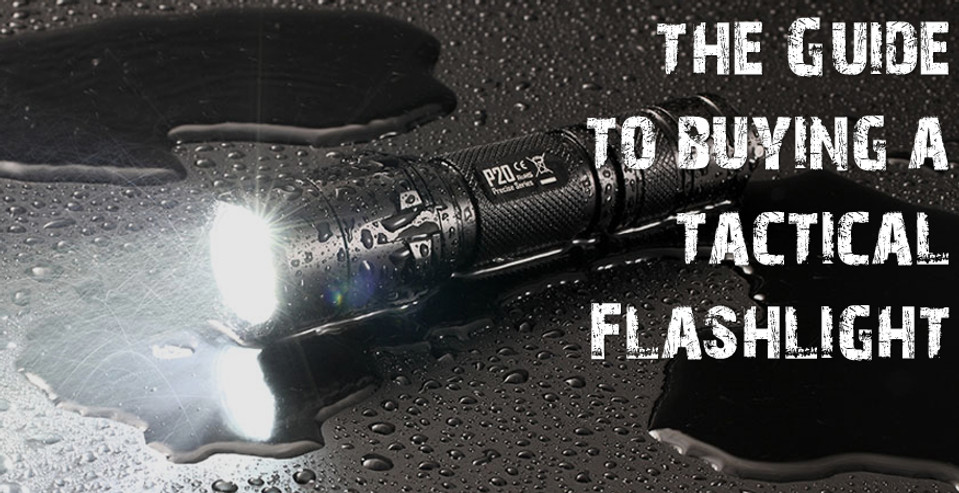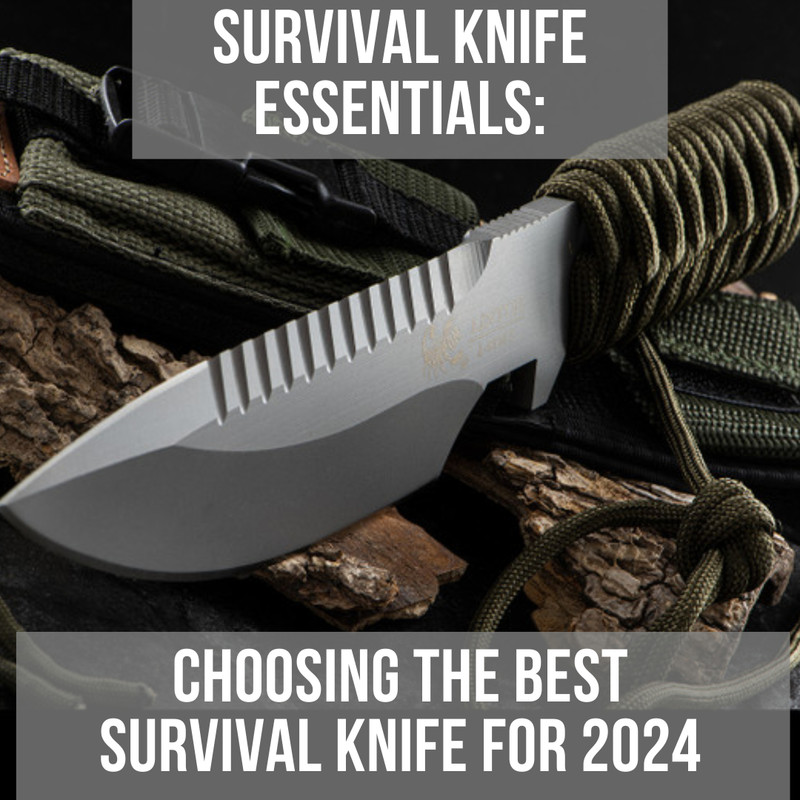The Complete Tactical Flashlight Buying Guide
Posted by HH on 18th Sep 2015
You will struggle to find someone who will not have need for a flashlight at some point. Everyone from the military and emergency services to hunters, hikers or people who walk their dog. The point we are making is that everyone needs a flashlight, and it’s not until you actually need it that you realise you should have one around. In this post, we are going to talk you through all the jargon surrounding flashlights and what all the terms mean. Then we are going to look at 6 things you really need to think about when choosing the right tactical flashlight for you.
What is a tactical flashlight?
Tactical: ‘of or relating to a manoeuvre or plan of action designed as an expedient toward gaining a desired end or temporary advantage’
What does this mean? It means that tactical flashlights are used as tools in order to achieve a desired outcome. An example would be to walk through some woodland at night, and not walk into a tree. Tactical flashlights are built to be used and built to last. Generally they have much higher standards than your average flashlight.
Tactical Flashlight Myths
People often assume that a tactical flashlight is big and bulky and reserved for security guards. This really isn’t the case. Technology has moved on from those days and now tactical flashlights can come in all shapes and sizes. If you want to own a big heavy duty flashlight, you still can, but if you want one that is more pocket sized, then that is also available. The biggest technological advancement is the of LED bulbs which have helped the flashlights to become smaller, lighter, more powerful and more energy efficient. Put that together and you can have a flashlight that’s stupidly powerful in a really small size.
Another myth is that tactical flashlights require weird and wonderful shaped batteries that may be ridiculously powerful, but if it runs out trying to replace them is like trying to find a Cheetah in the wild. This is no longer true; you can get tactical flashlights with batteries that are both manageable in size, powerful and readily available.
Parts of a Tactical Flashlight
ANSI FL1 Standards
In 2009 the American National Standards Institute approved a specification standard for flashlights. Until then there had been no official standard. The ANSI FL1 standard is the result of this. It helps even the playing field for all flashlight makers and helps you guys make better and more informed buying choices. Below we’ve set out how the system works.
Light Output: This is a Lumens rating that shows the total amount of light that comes out of the front of the flashlight.
Run Time: This is the amount of time it will take for light to get to 10% of its initial output. An example would be that if a flashlight started at 100 Lumens this is the length of time of continuous light that it would take to get down to 10 Lumens.
Beam Distance: This is the measurement in meters of the distance at which the intensity of the beam reaches 0.25 lux which is the approximated amount of light of a full moon on a clear night.
Peak Beam Intensity: Measured in Candela this is the brightest point in the beam. Where Lumens tell how much light is coming out of the light in total Candela measures how bright the brightest point of the beam is.
Impact Resistance: Measured in meters this indicates the height that you could drop a flashlight from onto concrete and it still work properly. The light can also not have any cracks or breaks in it.
Water Resistance: There are three levels of water resistance that are found, those are IPX4, IPX7, and IPX8 (we will look at these in more depth later on)
6 choices that will help you buy the right tactical flashlight
For the people that do not have time right now to read all of the material in this particular artcle, here is a quick and dirty summary of the top 6 things to look for to ensure that you are getting a quality product. Some of you may have specific requirements that would make these tips change, but for the general public and EDC enthusiast that is not a ‘flashaholic’ these are some easy guidelines.
- Budget: You get what you pay for so unless it is a keychain flashlight or penlight most decent torches will start around £30+
- Size: If you are buying an EDC flashlight how big can you comfortably have with you all of the time. Otherwise if you are not keeping it with you all of the time how much space do you have to store it?
- Power Source: Do you want disposable or rechargeable batteries? And, do you want a standard size battery (easy to find) or a special battery (more power)?
- How Much Light: Is brighter always better?
- Durability: What materials? Type II or type III hard anodized aircraft grade aluminum with a LED bulb that is rated to at least IPX7 waterproofing?
- Other Considerations: Extras that you might find really useful.
Budget
Set yourself a budget. Generally with flashlights, quality costs. If you want a better quality flashlight, be prepared to pay more. If you want a decent tactical flashlight we recommend that the minimum budget you should have is £50. This will get you a decent flashlight with all the specs you need and expect from a tactical flashlight. If you want something cheaper then you can, but really they won’t be classed a tactical flashlights, instead they’d more likely fall into the category of EDC flashlights or keyring flashlights.
Size
Carefully consider how big a flashlight you want depending on what you plan on doing with it. Remember, if this is for everyday carry you need a torch that will not get in the way. Finding a balance of size and power is for your needs is key.
You can get micro and mini flashlights, but those wouldn’t be classed under the tactical flashlight umbrella. Small flashlights are definitely borderline, but they are very popular, so they make the cut.
Small Flashlight: Generally a small flashlight is 10-12 cm in length (4 inches or so in imperial). In most small flashlights, you will not be able to fit in double batteries but, you are able to have single battery set-up with more features. In this size you will find more options with tail switches and the lights can have a deeper reflector so they can throw their light farther. So although the power isn’t huge, you are starting to look at some good foundations to a tactical flashlight.
Medium Flashlight: A medium flashlight will be between 12 and 16 cm (6 inches or so). At this size you will find most flashlights will start to be run on two batteries and you also start getting flashlights that use 18500 and 18650 specialty batteries. With increased batteries, comes increased power. With increased power comes better LED’s which in turn leads to usually a higher lumen output. Lumen output also depends on things like reflector quality though.
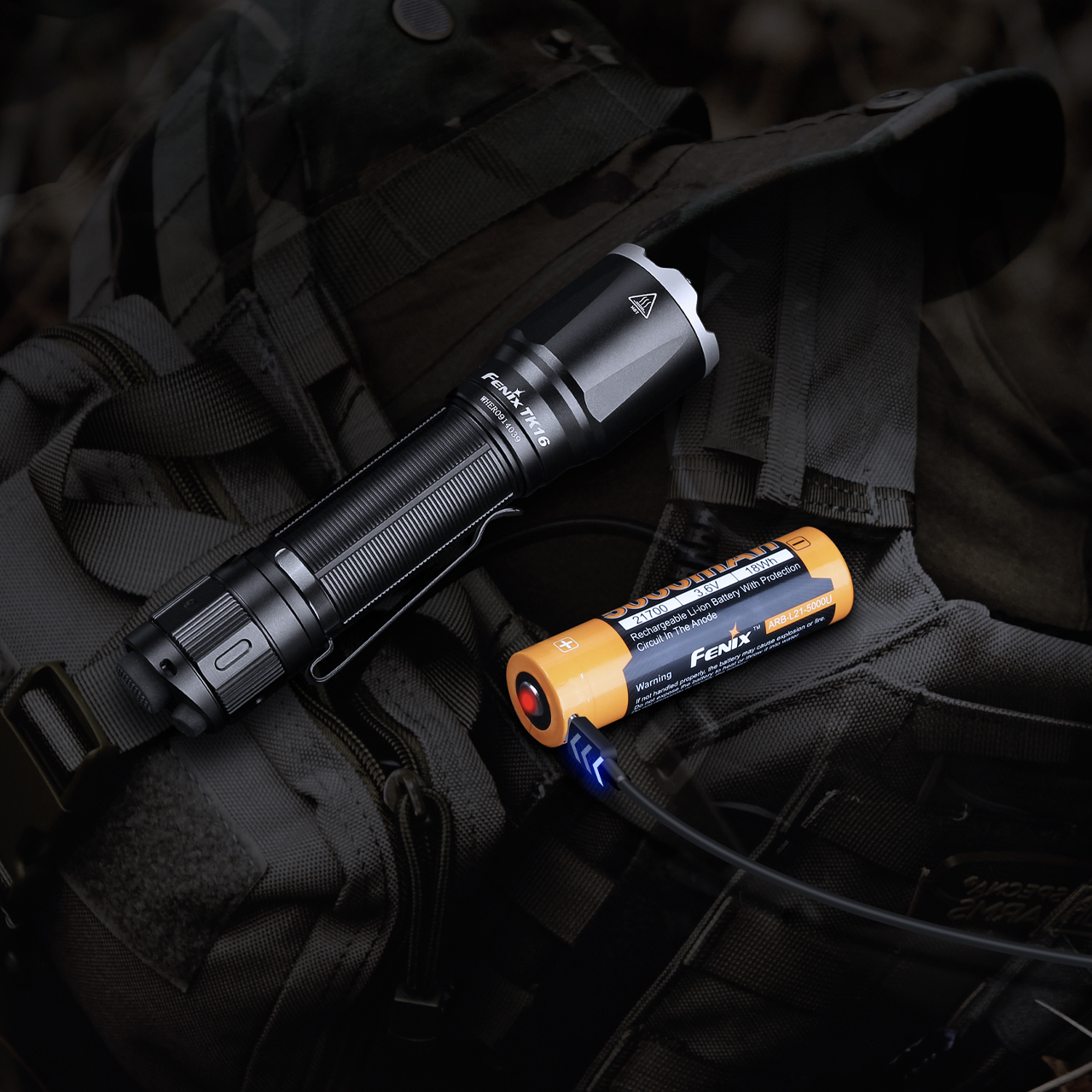
Large Flashlights: Here we will consider anything over 16 cm (6 inches) that can be carried easily. Like the previous section these tactical flashlights can output huge amounts of Lumens but with the extra added size these flashlights may have a few more features than the slightly smaller lights. Many have multiple settings, colours even number of LED’s. All of which make for extremely powerful flashlights!
Power Source
Power has got to be a key consideration. Some batteries are longer lasting, some give more power, others are more readily available. Each have their uses, but only some will be suited to you.
Disposable Alkaline: These are the standard size batteries that you are used to seeing AAA, AA, C, and D batteries. These batteries do not offer as much power as some other types of batteries but they are very easy to find (almost any corner shop or convenience shop. Often people in the prepper/survival world like flashlight that will work with standard size batteries, so they know that they will have easier access to new batteries. Alkaline batteries have a shelf life of around 2 years.
Disposable Lithium: These batteries are in almost every way the same as alkaline batteries except they have a greater power output, and hold more power to start with so generally last longer. Lithium batteries have a shelf life of around 10 years so they are a favourite of survivalists, preppers and bushcrafters! However, they are quite a bit more expensive than alkaline batteries. Some specialised batteries that fit into this group are the CR123A and the CR2 (pretty common in most tactical flashlights). Do not confuse these batteries with Lithium Ion batteries!
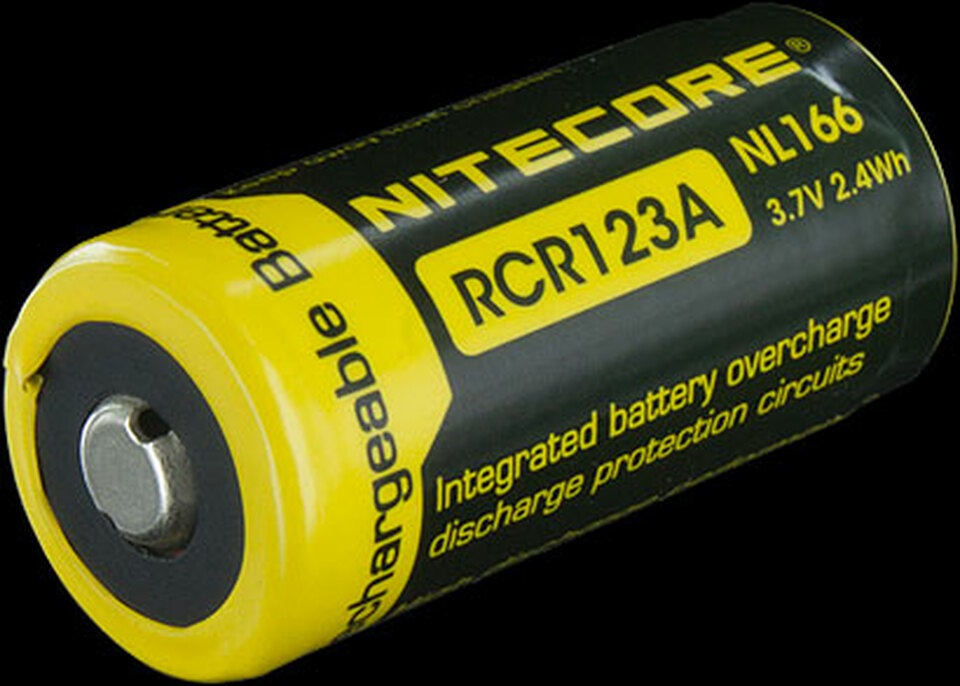
Rechargeable Cells: Rechargeable Li-Ion (Lithium Ion) cell batteries come in many different sizes. They offer great power output like the standard Lithium batteries, but these also have the ability to recharge. The downside is that the batteries are slightly more expensive and you need to buy a proper charger to go along with them so you don’t risk damaging the batteries. 18500, 18650, and RCR123A are common Li-Ion batteries.
(Note: Lithium batteries are tricky to post, and therefore some retailers will charge a premium to have them shipping to you).
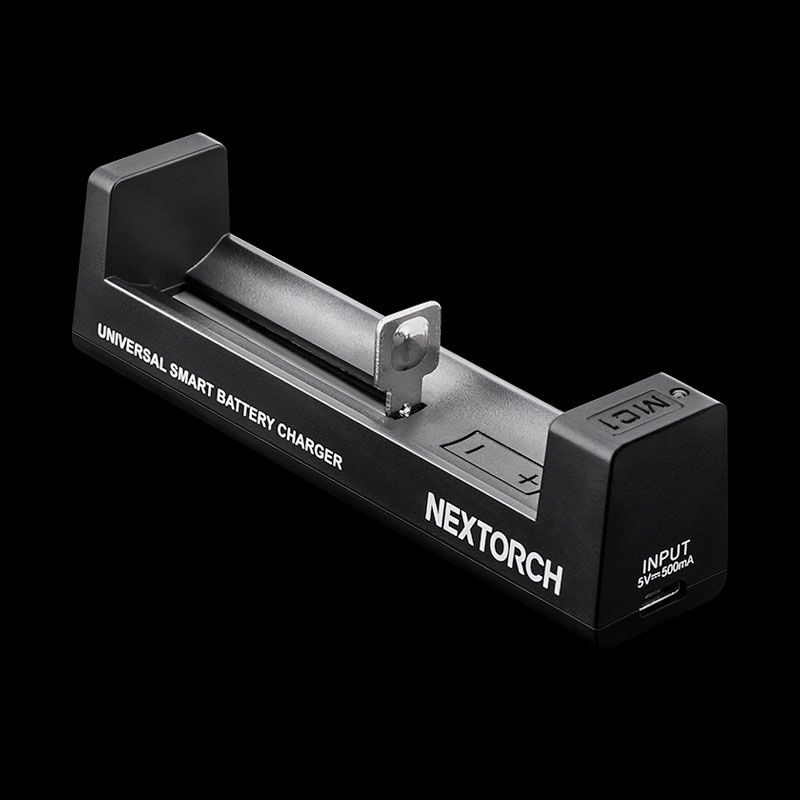
Integrated Rechargeable Pack: This is something that’s becoming more commonplace as batteries are built to hold their charge for longer. You’ll find that some flashlights can be charged up simply via a mains socket or USB socket. This is really useful if you are an urban dweller, but if you need your flashlight for periods where you are away from a plug or your laptop, you may struggle. These do help keep long-term costs down though if you plan on using your flashlight regularly.
Sprinter or Marathon Runner? What performance are you looking for?
How long do you want your flashlight to last? Are you a high intensity for 30 minutes then done kind of person, or would you rather slightly less intensity and a longer lasting performance? It’s always useful to look at the specs in particular run-time to lumens of output. This will give you a good idea of how long your flashlight will shine.
Light Output
There are a number of ways you can look at light output. Most people will look primarily at Lumens. This is pretty standard and realistically should be one of your first thoughts. However, there are two other things you should consider. Temperature and Beam Distance.
Temperature looks at the colour of light. For the scientific minds among you, you’ll recognise that light colour temperature is measured in degrees Kelvin. There are 3 general terms you should be aware of. ‘Warm White’ light is at the low end of the spectrum (2600-3500K) this gives off the yellowish light, like you find in an incandescent light bulb. Next you have ‘Neutral White’ light. This light is middle of the road, neither yellow or blue colours dominate. Finally you have ‘Cool White’ which is at the higher end of the spectrum (5000K+), this is mostly white light, with a bluish tint.
Beam distance looks at how far your flashlight can ‘throw’ the light. In simple terms, how far you will be able to see ahead of you. Some people will want this to be as big as possible, whereas others will prefer a much wider area illuminated instead.
Whether your flashlight is better for ‘throwing’ or ‘flooding’, is dependent on the design of the reflector and on the LED that is used. In general flashlights that are floody are better for close up activities and flashlights that have a long throw are for lighting up thing that are far away. You need to decide how far away you want to be able to see something and this will change the flashlight that you will want to buy.
Lumens are how you measure the amount of light energy or power of the light in total that comes out of the face of the flashlight. High Lumens means that you have a powerful LED and a powerful battery. You’ll see the word Lumens used everywhere by brands and companies, but really it isn’t the be all and end all. Beam distance and even candela’s are arguably more important. Even the quality of the reflector plays a part. Overall though it’s still a useful guide as more powerful Lumens does usually equate to a bigger light either ‘throw’ or ‘flood’.
For use outdoors you really want a flashlight that is over 150 lumens at a minimum. However, for tactical flashlight purposes we recommend you look for 300+ lumens.
150 – 299 Lumens: With this level of light output you could easily light up a large room, your entire backyard and be able to see pretty far out of a campsite. Between 150 and 300 lumens, if you were to shine to light at someone you could disorientate them for a short period.
300 – 699 Lumens: Now we enter the tactical zone. To reach these levels your flashlight with need the higher specification Lithium or Li-Ion batteries. With this level of lighting you can light a very big area with relative ease.
700+ Lumens: This is for those who want serious illumination. This is the level of power you want if you need maximum brightness for your job but still need flashlight you can carry by hand. People who are into bushcraft, military, search and rescue or part of the emergency services are the main people that tend to buy these. But, they are definitely not exclusive to them. If you’ve got some spare money, we have handheld flashlights that have output from 700 all the way up to 5,000 or 6,000 lumens such as the Imalent DDT40 which has 5,180 lumens!
Durability
The materials used in the making of the flashlight, has a direct impact on its durability. Certain materials are stronger, others lighter, others help prevent the
Plastics or Composites: You won’t see many of these types of flashlights at all, but they are available. However, if you are looking for a high quality flashlight you are better looking at one of the other materials below.
Anodized Aluminium: This is the material that you’ll find in most modern flashlights today. You want to make sure that you have at least type II anodizing as that is the standard, but you can also get type III which is even harder.
Stainless Steel: Stainless steel is a very strong and durable material but it is heavy.
Titanium: Titanium is very strong like stainless steel and but much lighter. It’s a very good material, but if you want a flashlight made of titanium, you need to be willing to pay for it.
Water Resistance Ratings
Water resistance or waterproofing aren’t the two things that will top your priority list when buying a flashlight. But, having a flashlight that you know can withstand water be it either rain, or being dropped in a puddle is always useful. We suggest at least getting IPX7 water resistant lights as you do not want you flashlight to stop working in the event of an accident.
IPX4: This basically means that the flashlight is splash resistant. This should not be submerged in water or it will probably get in.
IPX7: This is submersible but only to 1 meter for up to 30 minutes according to the specification.
IPX8: This is the highest level of waterproofing that you will see in most flashlights, it is submersible to more than 1 meter for up to 4 hours.
Other considerations
What Kind Of Switch Type Do You Want?
Flashlights come in three main switch types. They are the head/tail twist switch, the body switch, and the tail switch. For a Tactical flashlight you really want a tail switch, however a body switch is more than acceptable. Head and Tail twist switches are predominantly designed for much smaller flashlights.
Body: The body switch was the most popular style and is like what you would find on a whole host of different brands. It allows for a very natural grip that you would not be able to do with other types of switches.
Tail: The tail switch is the most popular and usually the favourite type of switch for a tactical flashlight. Having the button on the bottom of the torch allows an overhand grip that is already in a fist position, which allows for easy flashlight usage.
Bezels
There are two types of bezel you need to be aware of: Castellated and flat. With a flat bezel you can fully hide the light of the flashlight without turning it off. As long as you fully cover the bezel. With a castellated bezel the slight gaps in the bezel means you will not be able to cover the light with such ease. However, you will be able to stand the flashlight upright and get an ambient glow underneath.
How Many Brightness Levels Do You Want?
Every person wants something different out of their flashlight and every flashlight manufacturer has their own idea of what the best way to provide light is. A good tactical flashlight should have a number of modes. Even if you think you will not use them. Because little things like that you’ll find that you actually use more than you think. Also if you want to save battery life, but still want to see, you can always turn down the brightness instead of having to turn off the flashlight.
On/Off: There are no modes or brightness levels, just full power. The advantage of this is that when you push that button you know exactly what is going to come out. Some of you may feel that all of brightness levels and modes can be confusing and just get in the way.
Two Brightness Levels: High and Low, these lights do not offer anything fancy except the ability to have a long battery life on a low setting aside from just having max power all of the time.
Many Brightness Levels: There are flashlights that have up to 10 different brightness levels and some even with dials that support continuous change. Obviously the brighter the light the lower the run-time, so having just enough light for what you are doing is a huge benefit. Rather than having not enough or having too much and having your flashlight die out very quickly.
Do You Want Any Special Light Modes?
There are three special light modes that a decent flashlight comes with. They are Strobe, SOS, and Beacon.
Strobe: Strobe is designed to disorient somebody; it is a very fast and super bright blinking light that is usually in a changing pattern to really confuse people. This is a feature that many police officers would consider a necessity.
SOS: SOS or …—… in Morse code is used for emergency purposes. It is originally a naval term for save our ship. This would be useful for anybody that was out camping or stuck in a survival situation.
Beacon: A beacon is like a lighthouse, it blinks at full brightness every few seconds. The purpose of this mode is for survival. You would use this when you want to get seen. Blinking every few seconds conserves battery life as long as possible, but still makes you really recognisable!
Tactical Ring
A tactical ring is a nice addition to any flashlight for two reasons: Firstly is you were to lay your flashlight on a wonky on uneven surface, the ring would prevent it rolling away (pretty useful). The second use is for hand position. The ring positioning will prevent your hand slipping off the flashlight, which if you are using it in wet conditions if very helpful.
Light Filters
Some flashlights come with light filters that you can put over the top of the flashlight so it will shine another colour, or have inbuilt coloured LEDs. Red is popular for night vision (doesn’t strain your eyes or scare wildlife), blue and yellow are popular for seeing blood (also UV light), and green does not spook animals while hunting and can not be seen from the side so you can preserve your location. All of which are a bit more specific but equally useful depending on your needs.
What next?
We’ve just given you a whole lot of knowledge. Too much retain at once most likely, but if there is one thing you should take away from this is that buying a flashlight isn’t something you should really do on the fly. Take your time and think about what you need it for.




